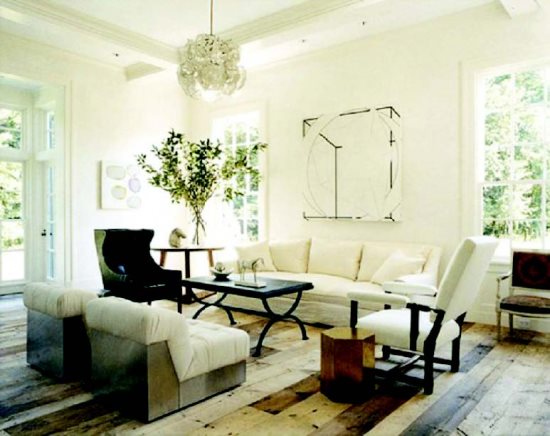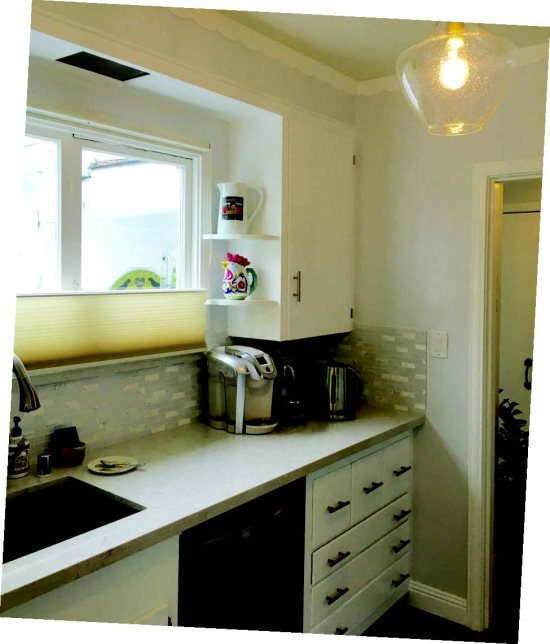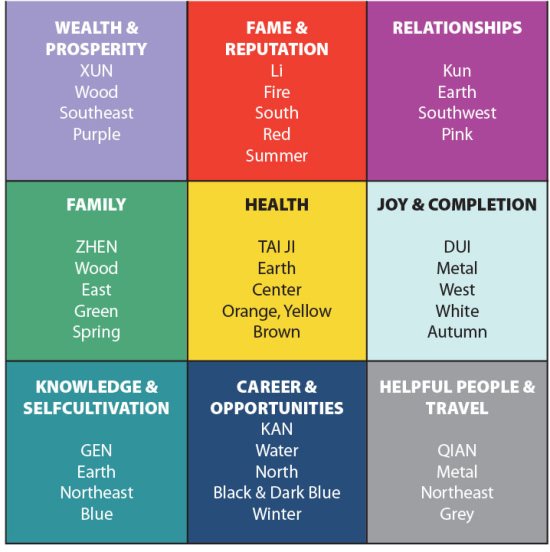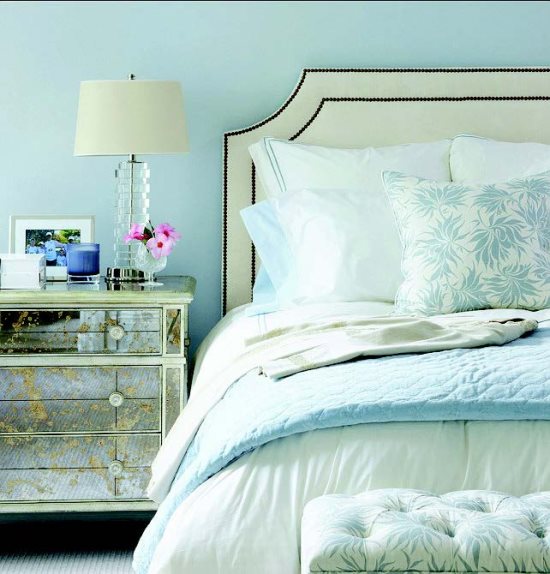 | | | Benjamin Moore's Mayonnaise is a great flow color that can go right into the living room or dining room. Photos provided | | | | | | Now that spring is truly here, are you feeling inspired by all the local color?
 Nature-inspired color is the real purpose of balanced feng shui in your home - color that mirrors the barely translucent dewy sky, the persimmon fruit, the slate earth of the coast, the dancing blues of the waves, or the barky ruddiness of the redwoods. If we want the benefits of nature indoors, one key element is through the colors we choose from our interaction with nature around us here in the Bay Area.
Nature-inspired color is the real purpose of balanced feng shui in your home - color that mirrors the barely translucent dewy sky, the persimmon fruit, the slate earth of the coast, the dancing blues of the waves, or the barky ruddiness of the redwoods. If we want the benefits of nature indoors, one key element is through the colors we choose from our interaction with nature around us here in the Bay Area.
 Color influences the vibe of various rooms, infuses our senses with a backdrop for our lives, and creates necessary depth in a room's canvas. Color is meaningful and important for an energy-rich environment and life. The right colors create restorative calm in a master bedroom, a complimentary reflection for the food we eat in the kitchen, and sets the tone for a cozy living room or intimate dining room.
Color influences the vibe of various rooms, infuses our senses with a backdrop for our lives, and creates necessary depth in a room's canvas. Color is meaningful and important for an energy-rich environment and life. The right colors create restorative calm in a master bedroom, a complimentary reflection for the food we eat in the kitchen, and sets the tone for a cozy living room or intimate dining room.
 But for some, color is daunting. Many clients tell me that they would no sooner be able to select a hue of their dreams for their home even if they personally dreamt it. Seriously and to be sure, color selection can be a happy journey if you are prepared to do some upfront legwork first.
But for some, color is daunting. Many clients tell me that they would no sooner be able to select a hue of their dreams for their home even if they personally dreamt it. Seriously and to be sure, color selection can be a happy journey if you are prepared to do some upfront legwork first.
 First, it's a great idea to spend some time thinking about the colors that you love. What makes you feel happy and alive? Forget about trends; spend time researching and thinking about the colors that resonate with you, or certain colors that inspire you in nature. Consider the amount of natural light in your space. Is there more or less natural light, depending on the different location of the rooms in your home? Those rooms with southern exposure can possibly handle darker, stronger hues. If rooms do not receive adequate natural light and are dark or small, choosing lighter colors will brighten and vastly enlarge the space. In addition, consider having a "flow color" or the one neutral that will be on most of the walls of the common areas, like stairwells and hallways. If the layout supports it, paint the flow color in your living room, kitchen or dining room; those decisions can also be made ahead of time.
First, it's a great idea to spend some time thinking about the colors that you love. What makes you feel happy and alive? Forget about trends; spend time researching and thinking about the colors that resonate with you, or certain colors that inspire you in nature. Consider the amount of natural light in your space. Is there more or less natural light, depending on the different location of the rooms in your home? Those rooms with southern exposure can possibly handle darker, stronger hues. If rooms do not receive adequate natural light and are dark or small, choosing lighter colors will brighten and vastly enlarge the space. In addition, consider having a "flow color" or the one neutral that will be on most of the walls of the common areas, like stairwells and hallways. If the layout supports it, paint the flow color in your living room, kitchen or dining room; those decisions can also be made ahead of time.
 Benjamin Moore's "Full Moon" is a bright light grey that fits the flow color task, or if you prefer a creamier hue, take a look at Benjamin Moore's "Mayonnaise" which has a lot of creamy warmth.
Benjamin Moore's "Full Moon" is a bright light grey that fits the flow color task, or if you prefer a creamier hue, take a look at Benjamin Moore's "Mayonnaise" which has a lot of creamy warmth.
 Deciding on a color should take you on an exquisitely straightforward journey that includes narrowing down your favorite two or three finalists. Paint brushouts on the lightest walls (opposite windows) and darkest walls (with the windows) and then look at your picks morning, noon and night. Ask your partner or kids to weigh in as well and see if a favorite doesn't begin to emerge.
Deciding on a color should take you on an exquisitely straightforward journey that includes narrowing down your favorite two or three finalists. Paint brushouts on the lightest walls (opposite windows) and darkest walls (with the windows) and then look at your picks morning, noon and night. Ask your partner or kids to weigh in as well and see if a favorite doesn't begin to emerge.
 Following these steps will help you end up with a color you absolutely love, with no do-overs required!
Following these steps will help you end up with a color you absolutely love, with no do-overs required!
 Second, consider the room you are painting. Restorative feng shui recommends softer, lighter, more "Yin" versions of most colors for master bedrooms and if you want a stronger, more "Yang" hue of color in your bedroom then it is wise to paint that stronger color only on the wall behind your bed, so in effect, you won't see the color as you sleep.
Second, consider the room you are painting. Restorative feng shui recommends softer, lighter, more "Yin" versions of most colors for master bedrooms and if you want a stronger, more "Yang" hue of color in your bedroom then it is wise to paint that stronger color only on the wall behind your bed, so in effect, you won't see the color as you sleep.
 My current favorite color is a soft ethereal blue Benjamin Moore color called Constellation, which also conjures up starry dreamy nights in the one spot you spend the most amount of time in the evenings. If you want a stronger pop of color, consider painting a pass through room like a boot, laundry or guest bath in a bolder hue. Benjamin Moore's 2018 Color of the Year is a festive bold red called Caliente and it can work in some of those rooms, but if you are interested in good feng shui, please never paint any bedroom red. Over time you may find yourself either awake all night or a tad angry when you wake up.
My current favorite color is a soft ethereal blue Benjamin Moore color called Constellation, which also conjures up starry dreamy nights in the one spot you spend the most amount of time in the evenings. If you want a stronger pop of color, consider painting a pass through room like a boot, laundry or guest bath in a bolder hue. Benjamin Moore's 2018 Color of the Year is a festive bold red called Caliente and it can work in some of those rooms, but if you are interested in good feng shui, please never paint any bedroom red. Over time you may find yourself either awake all night or a tad angry when you wake up.
 The last part to consider is that color can be a major feng shui adjustment in your space, in other words, the colors you choose can strengthen or weaken the feng shui of your home or office. Looking at the feng shui map or Bagua you can discern Five Elements of Water (Career), Wood (Family & Wealth), Fire (Reputation), Earth (Health, Relationships and Wisdom), and Metal (Children, Helpful People).
The last part to consider is that color can be a major feng shui adjustment in your space, in other words, the colors you choose can strengthen or weaken the feng shui of your home or office. Looking at the feng shui map or Bagua you can discern Five Elements of Water (Career), Wood (Family & Wealth), Fire (Reputation), Earth (Health, Relationships and Wisdom), and Metal (Children, Helpful People).

 When you hold the Bagua looking into your home, for example, Relationships are the far right area and Wealth is far left. Where is the room located that you want to paint? Are your hallways or stairs in the center, or off to the right? Each element has colors that represent it but you are not limited to just those colors; you can also pick the elemental color scheme that creates or supports the area you want to paint. Other colors that enliven and strengthen feng shui are the colors that symbolize the element that produces or creates the area that you want to paint.
When you hold the Bagua looking into your home, for example, Relationships are the far right area and Wealth is far left. Where is the room located that you want to paint? Are your hallways or stairs in the center, or off to the right? Each element has colors that represent it but you are not limited to just those colors; you can also pick the elemental color scheme that creates or supports the area you want to paint. Other colors that enliven and strengthen feng shui are the colors that symbolize the element that produces or creates the area that you want to paint.
 Consider the creative cycle: water creates wood, wood creates fire, fire creates earth, earth creates metal, and metal creates water. So for example, a client of mine had her master bedroom in the wealth area (ruled by wood) and chose another lovely Benjamin Moore blue, Harbor Haze, to represent water, which creates wood. Getting some professional guidance might also be fun, especially if you are interested in this last step of incorporating feng shui. A professional can help with your color choices that support your intention either way, and add the right decorative elements to the room to balance out any color choice and improve the flow of chi!
Consider the creative cycle: water creates wood, wood creates fire, fire creates earth, earth creates metal, and metal creates water. So for example, a client of mine had her master bedroom in the wealth area (ruled by wood) and chose another lovely Benjamin Moore blue, Harbor Haze, to represent water, which creates wood. Getting some professional guidance might also be fun, especially if you are interested in this last step of incorporating feng shui. A professional can help with your color choices that support your intention either way, and add the right decorative elements to the room to balance out any color choice and improve the flow of chi!
 Happy spring!
Happy spring!


|




